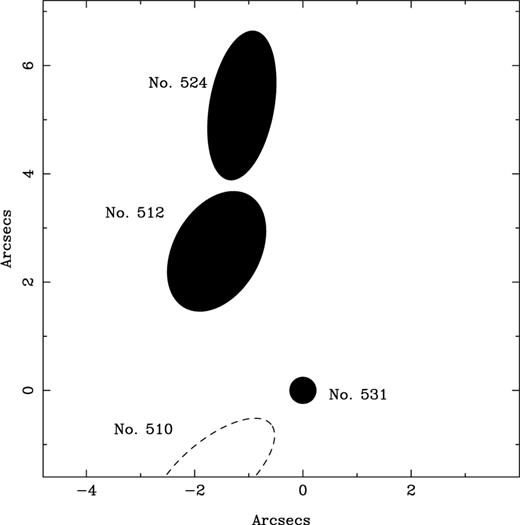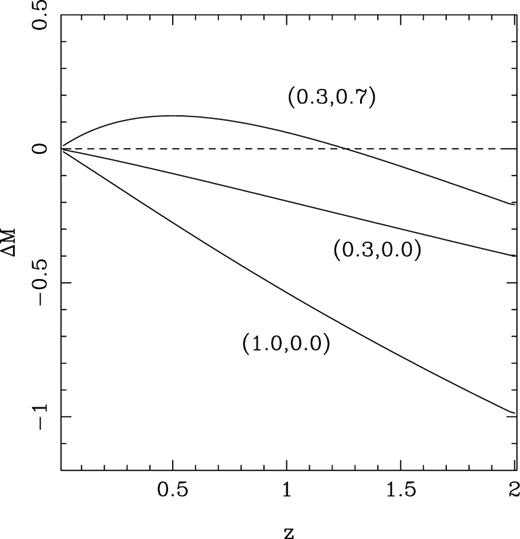-
PDF
- Split View
-
Views
-
Cite
Cite
Geraint F. Lewis, R.A. Ibata, Was Supernova 1997ff at z ∼ 1.7 magnified by gravitational lensing?, Monthly Notices of the Royal Astronomical Society, Volume 324, Issue 1, June 2001, Pages L25–L27, https://doi.org/10.1046/j.1365-8711.2001.04602.x
Close - Share Icon Share
Abstract
The quest for the cosmological parameters has come to fruition with the identification of a number of supernovae at a redshift of z ∼ 1. Analyses of the brightness of these standard candles reveal that the Universe is dominated by a large cosmological constant. The recent identification of the z ∼ 1.7 SN 1997ff in the northern Hubble Deep Field has provided further evidence for this cosmology. Here we examine the case for gravitational lensing of SN 1997ff owing to the presence of galaxies lying along our line of sight. We find that, while the alignment of SN 1997ff with foreground masses is not favourable for it to be multiply imaged and strongly magnified, two galaxies do lie close enough to result in significant magnification: µ ∼ 1.4 for the case where these elliptical galaxies have a velocity dispersion of 200 km s−1. Given the small difference between supernova brightnesses in different cosmologies, detailed modelling of the gravitational lensing properties of the intervening matter is therefore required before the true cosmological significance of SN 1997ff can be deduced.
1 Introduction
The search for the values of the cosmological parameters has occupied astronomers for almost a century. Recently, a study of the light curves of local Type Ia supernovae has provided an accurate calibration of their intrinsic luminosity (Hamuy et al. 1996; Riess et al. 1998). With such a standard candle in hand, the measurement of apparent supernova brightnesses at high redshift allows the underlying cosmological parameters to be determined. This has been the goal of two teams who have now discovered approaching 100 supernovae out to a redshift of z ∼ 1.2 (Schmidt et al. 1998; Perlmutter et al. 1999; Riess 2000). The results of these studies suggest that we live in a universe that is dominated by a cosmological constant, with Λ0 = 0.7, and with enough matter, Ω0 = 0.3, to flatten the overall topology, as seen in studies of the cosmic microwave background (Melchiorri et al. 2000).
With the release of the cosmological supernova results, a number of analyses of physical processes that could also dim distant supernovae, and therefore mimic a cosmological constant, were considered. These included gravitational lensing (e.g. Célérier 2000; Bergström et al. 2000), dust (Totani & Kobayashi 1999; Croft et al. 2000) and the evolution of supernova properties (Höflich et al. 2000); see Riess (2000) for a more complete description of these effects. Recently, however, the discovery of a supernova at a redshift of z ∼ 1.7 has been announced: see Located in the northern Hubble Deep Field (Williams et al. 1996; Ferguson, Dickinson & Williams 2000), this supernova, designated SN 1997ff, was identified via the comparison of exposures at differing epochs by Gilliland, Nugent & Phillips (1999). While a publication detailing the supernova has yet to appear, the press release announces that this system, with a photometric redshift of z = 1.7 × 0.15, represents the most distant supernova discovered and that it confirms the earlier conclusions of a cosmological constant dominated universe, as it is brighter than would be expected in a simple matter-dominated universe. Such dimming and brightening, relative to matter-dominated cosmologies, is a peculiarity expected in universes with a substantial cosmological constant, but is not consistent with the action of dust, gravitational lensing or supernova evolution.
An examination of the Hubble Deep Field, however, reveals that the host of SN 1997ff is seen in projection near two large elliptical systems at a redshift of z ∼ 0.56. In this Letter, we consider the gravitational lensing influence of these galaxies on the apparent brightness of SN 1997ff.
2 The environment of SN 1997ff
Examining the host galaxy of SN 1997ff in the Hubble Deep Field North reveals that it lies in close proximity to several other systems; this is presented schematically in Fig. 1. The labels for the objects depicted are taken from S. Gwyn's photometric catalogue of objects in the Hubble Deep Field (Gwyn & Hartwick 1996).1 The host of SN 1997ff is No. 531, with a tentative spectroscopic redshift of z ∼ 1.66, while Nos. 512 and 524 possess spectroscopic redshifts of z = 0.555 and 0.557 respectively (Cohen et al. 1996). System No. 510 possess a photometric redshift of z ∼ 1.9 and therefore probably lies beyond the host of SN 1997ff. Two other systems at a redshift of z ∼ 0.85 lie off the bottom right-hand corner of the plot, but, as these are at a greater projected distance than galaxy No. 512, they are neglected in this analysis.

Schematic depiction of the environment of the host galaxy of SN 1997ff (No. 531). Both galaxies 512 and 524 have spectroscopic redshifts of z ∼ 0.56, while No. 510 has a photometric redshift of z ∼ 1.9.
3 Gravitational lensing
Given their proximity to the line of sight, it is prudent to consider the gravitational lensing influence of galaxies 512 and 524 on the observed brightness of SN 1997ff. For galactic-mass objects at cosmological distances, the typical scale for strong lensing is ∼1 arcsec and, given the separation of the galaxies and the host of SN 1997ff (distances of 3.0 arcsec for No. 512 and 5.4 arcsec for No. 524), there is little possibility that the supernova would have been multiply imaged or substantially magnified. More subtle magnifications, however, will occur outside the region of multiple imaging.
To examine this further we adopt the simple pseudo-isothermal model of the two-dimensional gravitational potential to represent each of the foreground galaxies (Kochanek et al. 1989). These are assumed to be spherical and are centred on the optical positions of Nos. 512 and 524. The normalization of this potential depends upon the velocity dispersion of the lensing objects and the ratio of the lens–source and observer–source angular diameter distances. Calculating the distances in various cosmologies, including those with a substantial Λ-term, using the algorithms of Kayser, Helbig & Schramm (1997), it is found that the normalization is relatively insensitive to the cosmological parameters, with a < 5 per cent variation between the total magnifications for reasonable cosmologies. It is also assumed that galaxies 512 and 524 have the same velocity dispersion.
Three fiducial values of the velocity dispersion are considered, 100, 200 and 300 km s−1, the central value representing a typical elliptical galaxy (Whitmore, McElroy & Tonry 1985). For the lower velocity dispersion of 100 km s−1, the resulting gravitational lensing magnification of SN 1997ff owing to galaxies 512 and 524 is only µ ∼ 1.08. Considering instead the more typical value of 200 km s−1, the gravitational lensing magnification is µ ∼ 1.42, corresponding to a brightening of 0.38 mag. If galaxies 512 and 524 are massive ellipticals, with velocity dispersions of 300 km s−1, the magnification is µ ∼ 2.92, a brightening of 1.16 mag.
4 Discussion and conclusions
The simple analysis presented in this paper demonstrates that it is likely that the recently identified high-redshift supernova, SN 1997ff, was mildly magnified by the gravitational lensing influence of two galaxies lying close to the line of sight. The magnification is dependent upon the mass of the lensing galaxies, but, if these are typical elliptical galaxies, SN 1997ff appears brighter by 0.38 mag. While this value will depend upon the assumed form of the mass distribution in the lensing galaxy, the estimate of the magnification presented here will be of the right order.
The difference in apparent brightness of a standard candle in different cosmologies is presented in Fig. 2. At z = 1.7, the difference between alternative world models is slight: for instance, the dark energy dominated model predicts that objects will be only 0.13 mag brighter than in an empty-universe model. Our analysis suggests that gravitational lensing enhanced the magnitude of SN 1997ff by ∼0.4 mag, an effect larger than the difference between those two cosmologies. Indeed, in the light of our gravitational lensing analysis, the new supernova datum may be in closer agreement with an empty-universe model (although, of course, our analysis does not affect previous conclusions drawn from the sample of lower redshift supernovae). For the true cosmological significance of SN 1997ff to be determined, therefore, a detailed model of the gravitational lensing in this system is required.

The difference in apparent magnitude of a standard candle between an empty universe (dashed line at ΔM = 0) and other cosmologies. The brackets list the parameters (Ω0, Λ0) of the model.
While SN 1997ff is the first supernova to be identified in the higher redshift Universe, it is likely that others too will be found in similar circumstances. Hence the determination of the cosmological parameters via supernova explosions is likely to become tangled with the problem of understanding the mass distribution of lensing galaxies, something that has dogged the determination of the Hubble constant from gravitational lensing time delays for a number of years (e.g. Schechter et al. 1997).
References



